Potential Impacts of Climate Change on the Al Abila Dam in the Western Desert of Iraq
Abstract
:1. Introduction
2. Materials and Methods
2.1. Study Area and Data Used
2.2. Methodology Overview
- Using GCMs to evaluate climate variables on a large scale.
- Applying GCMs to downscale the climatic variables to local scales.
- Simulating the influence of climate change on the Al Abila dam utilizing the WHCatch model.
2.2.1. Climate Variable Simulation and GCMs
2.2.2. Downscaling Methods
Using the Statistical Downscaling Model (SDSM 4.2)
Predictor Variable Selection
2.2.3. Water Harvesting Model (WHCatch)
3. Results and Discussion
3.1. Statistical Downscaling
3.1.1. Performance of SDSM
3.1.2. Temperature and Precipitation Projection
3.2. Water Harvesting Model (WHCatch)
4. Conclusions
Author Contributions
Funding
Data Availability Statement
Conflicts of Interest
References
- IPCC. Climate Change 2022: Impacts, Adaptation, and Vulnerability. Contribution of Working Group II to the Sixth Assessment Report of the Intergovernmental Panel on Climate Change; Pörtner, H.-O., Roberts, D., Tignor, M., Poloczanska, E., Mintenbeck, K., Alegría, A., Craig, M., Langsdorf, S., Löschke, S., Möller, V., et al., Eds.; Cambridge University Press: Cambridge, UK, 2022; In Press. [Google Scholar]
- Adham, A.; Wesseling, J.G.; Abed, R.; Riksen, M.; Ouessar, M.; Ritsema, C.J. Assessing the impact of climate change on rainwater harvesting in the Oum Zessar watershed in Southeastern Tunisia. Agric. Water Manag. 2019, 221, 131–140. [Google Scholar] [CrossRef]
- IPCC. Climate Change 2014: Impacts, Adaptation and Vulnerability. Contribution of Working Group II to the Fifth Assessment Report of the Intergovernmental Panel on Climate Change; Field, C.B., Barros, V.R., Dokken, D.J., Mach, K.J., Mastrandrea, M.D., Bilir, T.E., Chatterjee, M., EBI, K.L., Estrada, Y.O., Genova, R.C., et al., Eds.; Cambridge University Press: Cambridge, UK; New York, NY, USA, 2014. [Google Scholar]
- Ministry of Foreign Affairs. Climate Change Profile, Iraq; Governmental Report; MoFAN: Den Haag, The Netherland, 2019. [Google Scholar]
- Ammar, A.; Riksen, M.; Ouessar, M.; Ritsema, C.J. Identification of suitable sites for rainwater harvesting structures in arid and semi-arid regions: A review. Int. Soil Water Conserv. Res. 2016, 4, 108–120. [Google Scholar] [CrossRef]
- Mukheibir, P. Water resources management strategies for adaptation to climate-induced impacts in South Africa. Water Resour. Manag. 2008, 22, 1259–1276. [Google Scholar] [CrossRef]
- Wilby, R.L.; Wigley, T.M.L. Precipitation predictors for downscaling: Observed and general circulation model relationships. Int. J. Climatol. 2000, 20, 641–661. [Google Scholar] [CrossRef]
- Ipcc-Tgic, A. General Guidelines on the Use of Scenario Data for Climate Impact and Adaptation Assessment. Version 2. 2007. Available online: http://www.ipcc-data.org/guidelines/TGICA_guidance_sdciaa_v2_final.pdf (accessed on 1 March 2023).
- Chen, J.; Brissette, F.P.; Poulin, A.; Leconte, R. Overall Uncertainty Study of the Hydrological Impacts of Climate Change for a Canadian Watershed. Water Resour. Res. 2011, 47, W12509. [Google Scholar] [CrossRef]
- Kingston, D.G.; Taylor, R.G. Sources of Uncertainty in Climate Change Impacts on River Discharge and Groundwater in a Headwater Catchment of the Upper Nile Basin, Uganda. Hydrol. Earth Syst. Sci. 2010, 14, 1297–1308. [Google Scholar] [CrossRef]
- Wilby, R.L.; Harris, I. A Framework for Assessing Uncertainties in Climate Change Impacts: Low-Flow Scenarios for the River Thames, UK. Water Resour. Res. 2006, 42, W02419. [Google Scholar] [CrossRef]
- Bhatta, B.; Shrestha, S.; Shrestha, P.K.; Talchabhadel, R. Evaluation and application of a SWAT model to assess the climate change impact on the hydrology of the Himalayan River Basin. Catena 2019, 181, 104082. [Google Scholar] [CrossRef]
- Chaemiso, S.E.; Abebe, A.; Pingale, S.M. Assessment of the impact of climate change on surface hydrological processes using SWAT: A case study of Omo-Gibe River basin, Ethiopia. Model. Earth Syst. Environ. 2016, 2, 1–15. [Google Scholar] [CrossRef]
- Chiew, F.H.S.; Whetton, P.H.; McMahon, T.; Pittock, B. Simulation of the impacts of climate change on runoff and soil moisture in Australian catchments. J. Hydrol. 1995, 167, 121–147. [Google Scholar] [CrossRef]
- Al-Ansari, N.; Abdellatif, M.; Ali, S.S.; Knutsson, S. Long term effect of climate change on rainfall in northwest Iraq. Cent. Eur. J. Eng. 2014, 4, 250–263. [Google Scholar] [CrossRef]
- Mohammad Reza Pour, O. The effect of climate change on stream flow used Statistical downscaling of HADCM3 model and Artificial Neural Networks. J. Water Soil Conserv. 2016, 23, 317–326. [Google Scholar]
- Adamo, N.; Al-Ansari, N.; Sissakian, V.K.; Knutsson, S.; Laue, J. Climate Change: Consequences on Iraq’s Environment. J. Earth Sci. Geotech. Eng. 2018, 8, 43–58. [Google Scholar]
- Hilo, A.N.; Saeed, F.H.; Al-Ansari, N. Impact of climate change on water resources of Dokan Dam Watershed. Engineering 2019, 11, 464–474. [Google Scholar] [CrossRef]
- Visweshwaran, R.; Ramsankaran, R.A.A.J.; Eldho, T.I.; Jha, M.K. Hydrological Impact Assessment of Future Climate Change on a Complex River Basin of Western Ghats, India. Water 2022, 14, 3571. [Google Scholar] [CrossRef]
- Soltani, F.; Javadi, S.; Roozbahani, A.; Massah Bavani, A.R.; Golmohammadi, G.; Berndtsson, R.; Ghordoyee Milan, S.; Maghsoudi, R. Assessing Climate Change Impact on Water Balance Components Using Integrated Groundwater–Surface Water Models (Case Study: Shazand Plain, Iran). Water 2023, 15, 813. [Google Scholar] [CrossRef]
- Adham, A.; Wesseling, J.G.; Riksen, M.; Ouessar, M.; Ritsema, C.J. A water harvesting model for optimizing rainwater harvesting in the wadi Oum Zessar watershed, Tunisia. Agric. Water Manag. 2016, 176, 191–202. [Google Scholar] [CrossRef]
- Adham, A.; Riksen, M.; Ouessar, M.; Ritsema, C.J. A Methodology to Assess and Evaluate Rainwater Harvesting Techniques in (Semi-) Arid Regions. Water 2016, 8, 198. [Google Scholar] [CrossRef]
- Kamel, A.; Sulaiman, S.; Sayl, K. Hydrologic study for Iraqi western desert to assessment of water harvesting projects. Iraqi J. Civ. Eng. 2012, 7, 2. [Google Scholar]
- Dibike, Y.B.; Coulibaly, P. Hydrologic impact of climate change in the Saguenay watershed: Comparison of downscaling methods and hydrologic models. J. Hydrol. 2005, 307, 145–163. [Google Scholar] [CrossRef]
- Xu, C. Climate change and hydrologic models: A review of existing gaps and recent research developments. Water Resour. Manag. 1999, 13, 369–382. [Google Scholar] [CrossRef]
- Taylor, K.E.; Stouffer, R.J.; Meehl, G.A. An overview of CMIP5 and the experiment design. Bull. Am. Meteorol. Soc. 2012, 93, 485–498. [Google Scholar] [CrossRef]
- Setegn, S.G.; Rayner, D.; Melesse, A.M. Climate change impact on agricultural water resources variability in the Northern Highlands of Ethiopia. In Nile River Basin: Hydrology, Climate and Water Use, 1st ed.; Melesse, A.M., Ed.; Springer: Berlin/Heidelberg, Germany, 2011; pp. 241–265. [Google Scholar] [CrossRef]
- Grotch, S.L.; MacCracken, M.C. The use of general circulation models to predict regional climatic change. J. Clim. 1991, 4, 286–303. [Google Scholar] [CrossRef]
- Hassan, Z.; Shamsudin, S.; Harun, S. Application of SDSM and LARS-WG for simulating and downscaling of rainfall and temperature. Theor. Appl. Climatol. 2014, 116, 243–257. [Google Scholar] [CrossRef]
- Boers, T.M.; Zondervan, K.; Ben-Asher, J. Micro-Catchment-Water-Harvesting (MCWH) for arid zone development. Agric. Water Manag. 1986, 12, 21–39. [Google Scholar] [CrossRef]
- Adham, A.; Seeyan, S.; Abed, R.; Mahdi, K.; Riksen, M.; Ritsema, C. Sustainability of the Al-Abila Dam in the Western Desert of Iraq. Water 2022, 14, 586. [Google Scholar] [CrossRef]
- Adham, A.; Abed, R.; Mahdi, K.; Hassan, W.H.; Riksen, M.; Ritsema, C. Rainwater Catchment System Reliability Analysis for Al Abila Dam in Iraq’s Western Desert. Water 2023, 15, 944. [Google Scholar] [CrossRef]
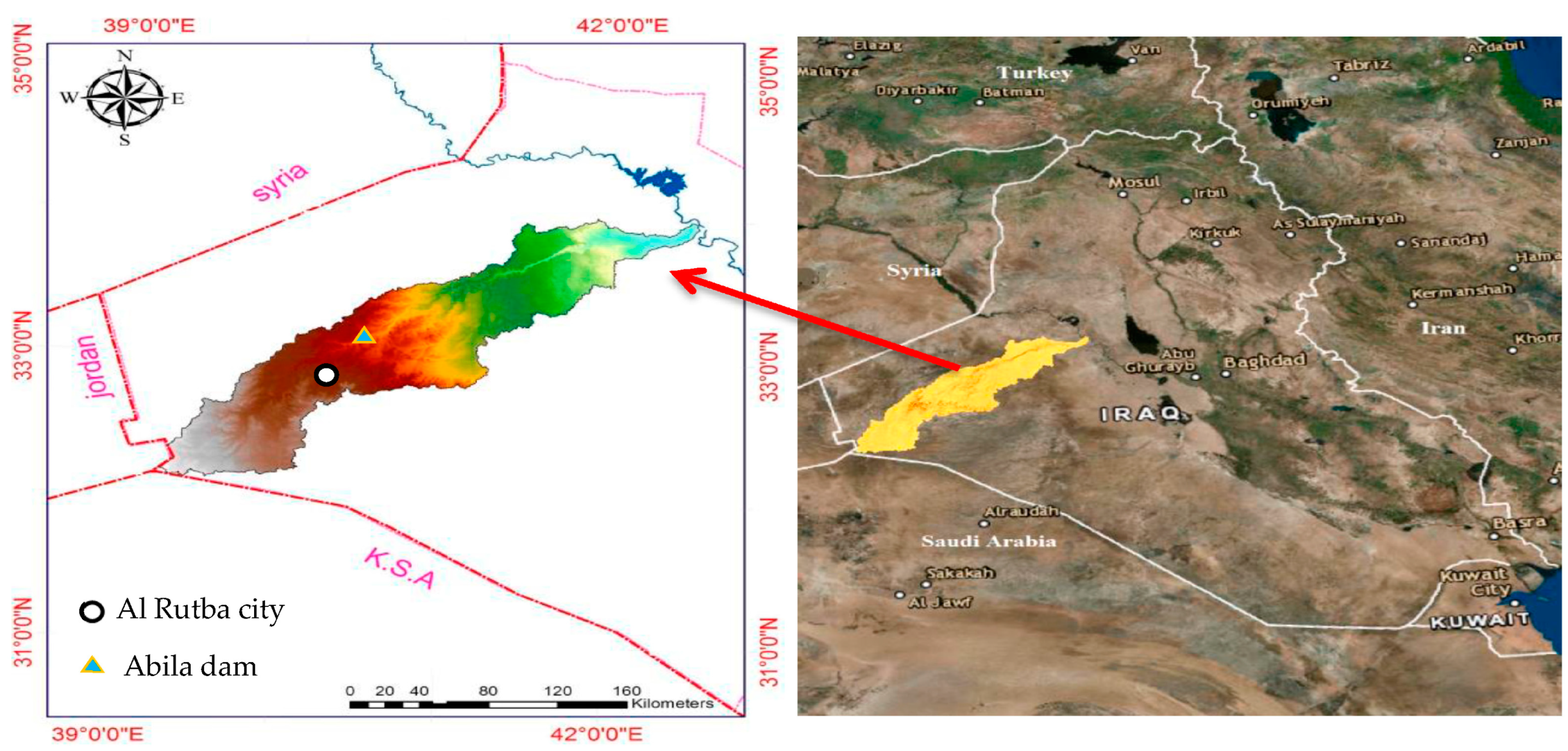

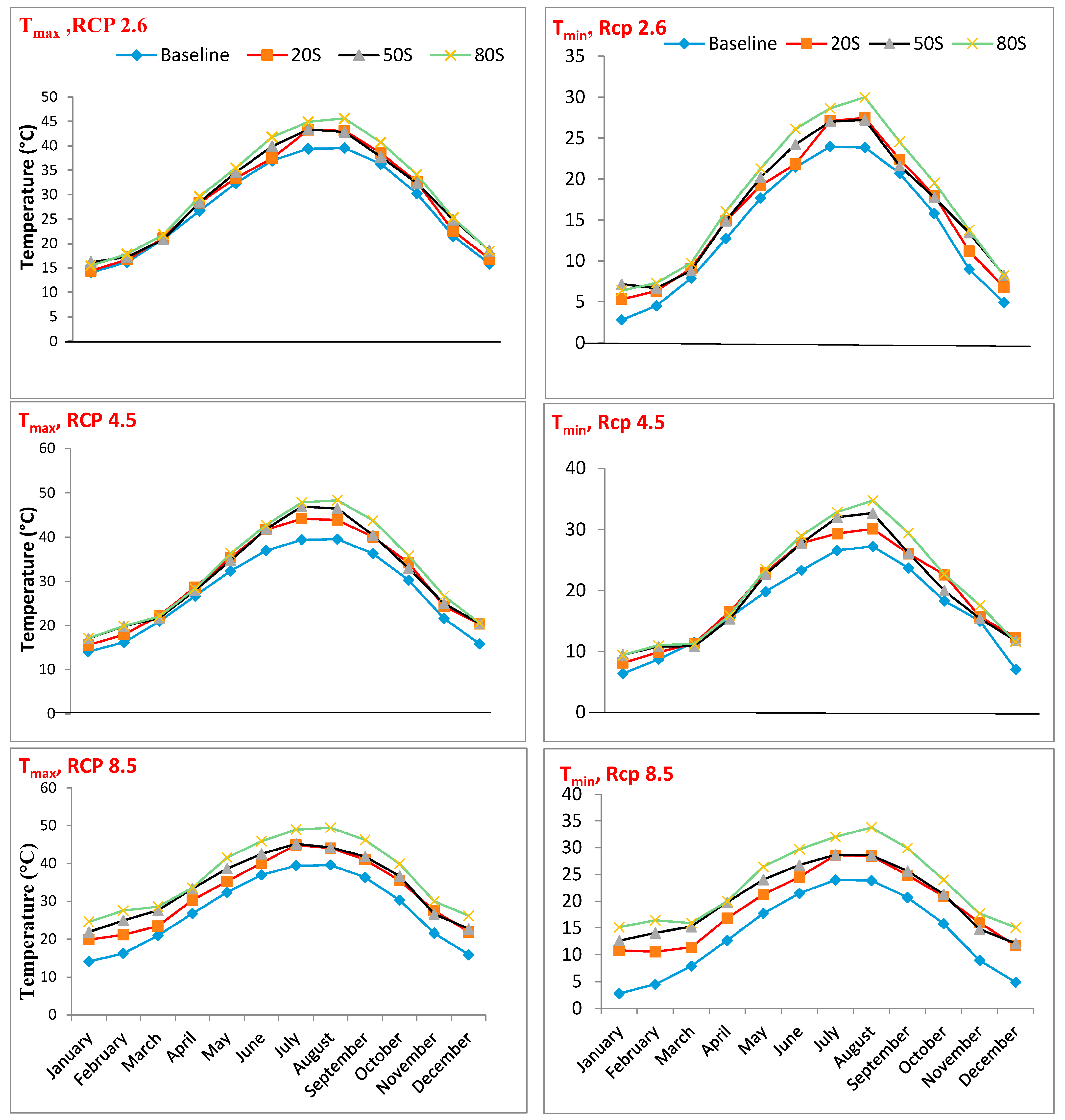
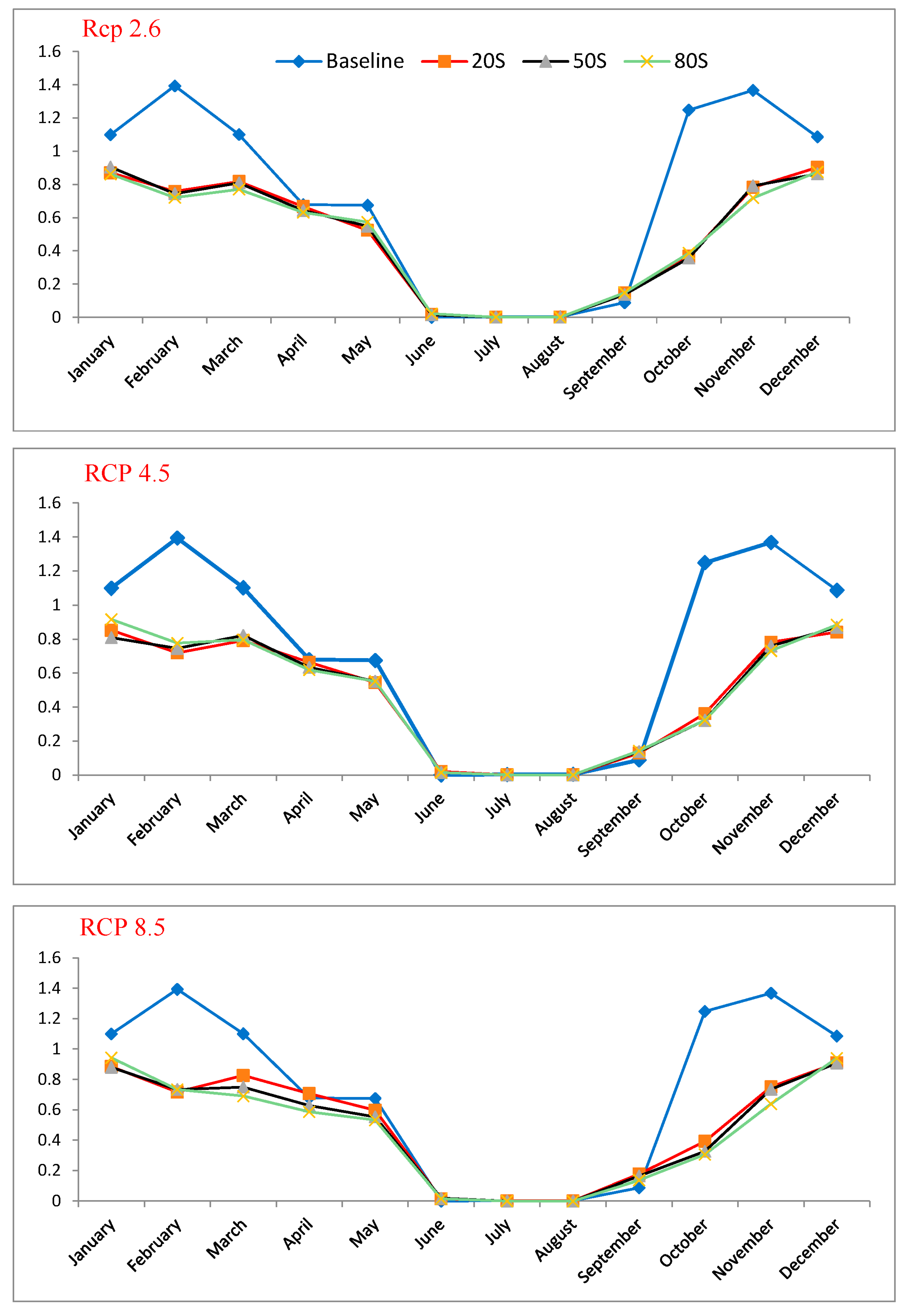
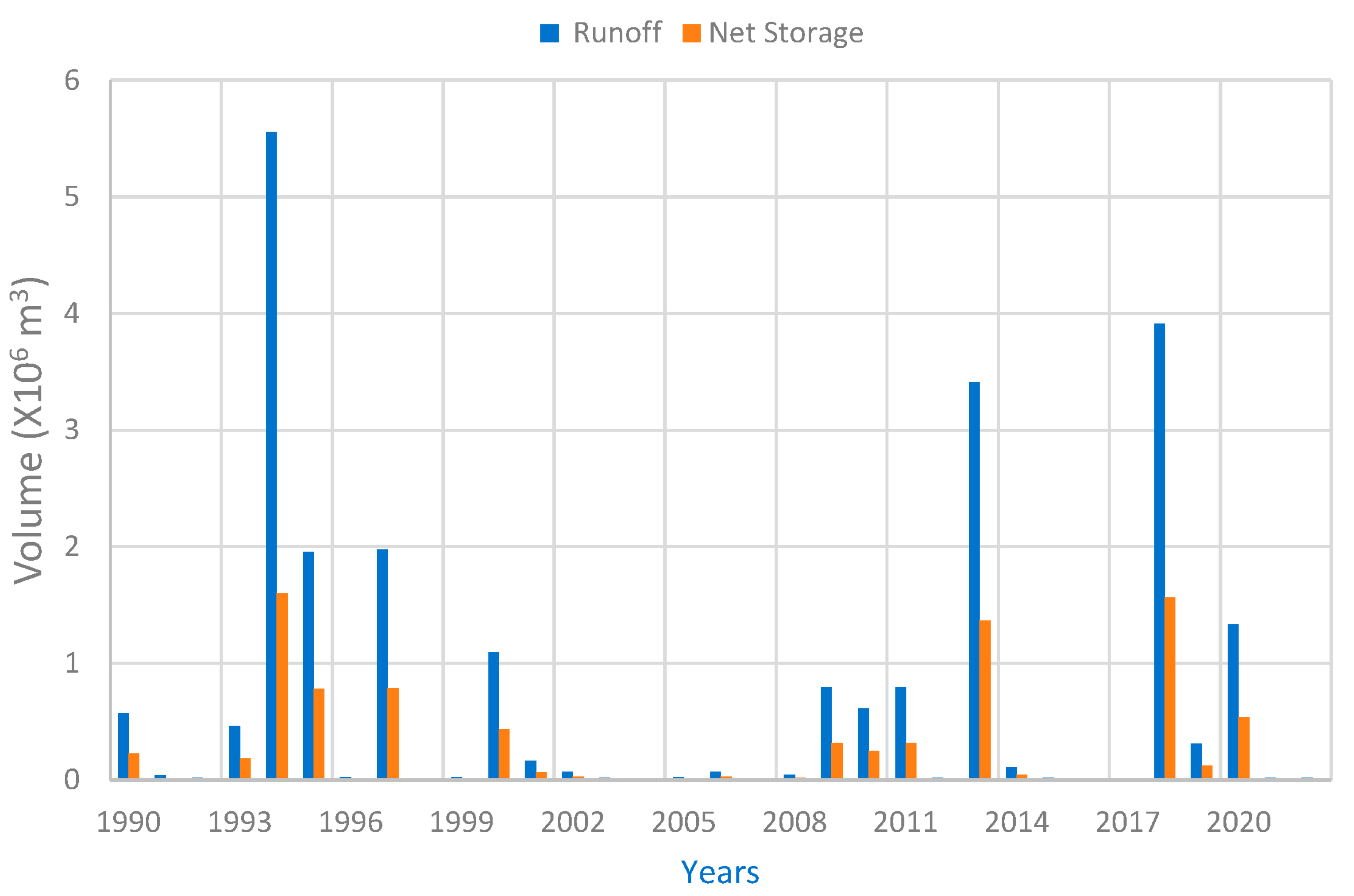
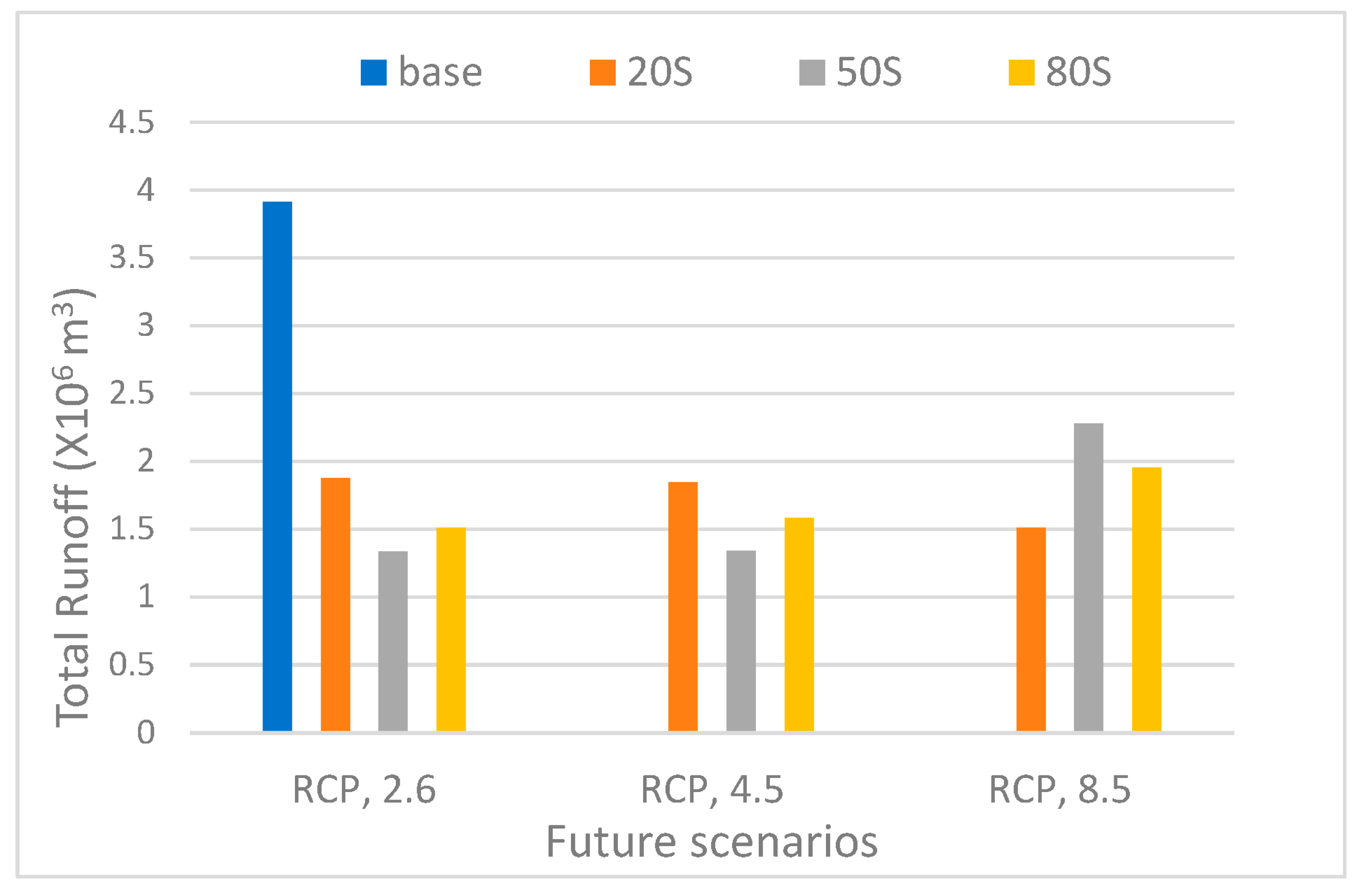

| Predictand | Predictor | Predictor Description | Partial r |
|---|---|---|---|
| precipitation | p5_ugl | 500 hPa Zonal wind component | −0.095 |
| shumgl | 1000 hPa Specific humidity | 0.192 | |
| tempgl | Air temperature at 2 m | −0.117 | |
| p1zhgl | 1000 hPa Divergence of true wind | 0.185 | |
| T_MAX | p500gl | 500 hPa Geopotential | 0.341 |
| shumgl | 1000 hPa Specific humidity | 0.104 | |
| tempgl | Air temperature at 2 m | 0.709 | |
| p1zhgl | 1000 hPa Divergence of true wind | 0.152 | |
| T_MIN | p500gl | 500 hPa Geopotential | 0.160 |
| shumgl | 1000 hPa Specific humidity | 0.364 | |
| tempgl | Air temperature at 2 m | 0.659 |
| T. max | T. min | Precipitation (%) | |||||||
|---|---|---|---|---|---|---|---|---|---|
| 2080s | 3.4 | 4.9 | 9.3 | 3.9 | 5.2 | 9.2 | −29 | −29.2 | −27.2 |
| 2050s | 2.2 | 3.7 | 6.3 | 2.7 | 4.1 | 6.5 | −30 | −28 | −29 |
| 2020s | 1.5 | 3.2 | 4.5 | 2.02 | 3.7 | 5.04 | −30.2 | −29 | −32 |
| Rcps | 2.6 | 4.5 | 8.5 | 2.6 | 4.5 | 8.5 | 2.6 | 4.5 | 8.5 |
Disclaimer/Publisher’s Note: The statements, opinions and data contained in all publications are solely those of the individual author(s) and contributor(s) and not of MDPI and/or the editor(s). MDPI and/or the editor(s) disclaim responsibility for any injury to people or property resulting from any ideas, methods, instructions or products referred to in the content. |
© 2023 by the authors. Licensee MDPI, Basel, Switzerland. This article is an open access article distributed under the terms and conditions of the Creative Commons Attribution (CC BY) license (https://creativecommons.org/licenses/by/4.0/).
Share and Cite
Abed, R.; Adham, A.; Allawi, M.F.; Ritsema, C. Potential Impacts of Climate Change on the Al Abila Dam in the Western Desert of Iraq. Hydrology 2023, 10, 183. https://doi.org/10.3390/hydrology10090183
Abed R, Adham A, Allawi MF, Ritsema C. Potential Impacts of Climate Change on the Al Abila Dam in the Western Desert of Iraq. Hydrology. 2023; 10(9):183. https://doi.org/10.3390/hydrology10090183
Chicago/Turabian StyleAbed, Rasha, Ammar Adham, Mohammed Falah Allawi, and Coen Ritsema. 2023. "Potential Impacts of Climate Change on the Al Abila Dam in the Western Desert of Iraq" Hydrology 10, no. 9: 183. https://doi.org/10.3390/hydrology10090183
APA StyleAbed, R., Adham, A., Allawi, M. F., & Ritsema, C. (2023). Potential Impacts of Climate Change on the Al Abila Dam in the Western Desert of Iraq. Hydrology, 10(9), 183. https://doi.org/10.3390/hydrology10090183







